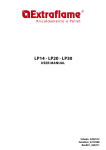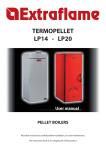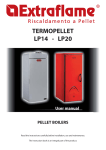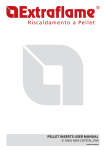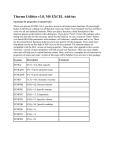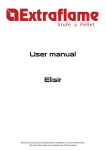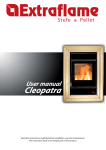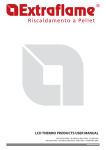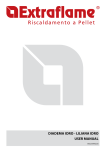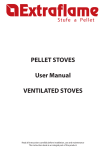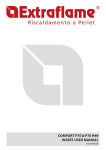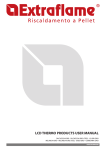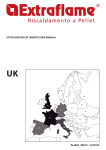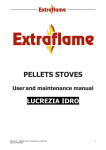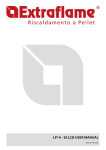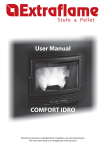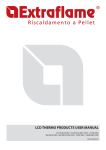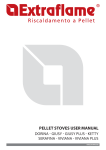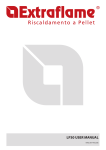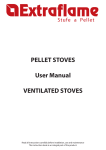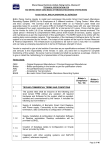Download English - La Nordica
Transcript
user manual lucrezia - lp14 - lp20 - lp30 Scheda_2202512 Rev002_200411 2 english................................................................ 9 1. WARNINGS...............................................................9 2.COMMISSIONING OPERATIONS....................... 10 16.3. status...................................................................................................28 16.4. user menu.........................................................................................28 16.4.1.set clock..........................................................................28 16.4.2.set chrono.....................................................................28 16.4.3.language.........................................................................29 16.4.4.heat exchanger cleaning.................................29 3.Mounting the tiles (lucrezia idro)........ 11 4.safety................................................................... 12 5.technical features....................................... 13 6.safety devices.................................................. 16 17.quick access diagram.................................. 30 18.lp30 display and PRODUCT FUNCTIONALITY........................................................ 31 19.lp30 menu structure.................................... 32 2.1. Burn pot bracket (lucrezia idro model only)................................................................................................10 6.1.Installation and safety devices................................17 6.2.Safety devices for closed vessel system...........17 6.3. distances of safety devices according to the Standard......................................................................................................17 7.HYDRAULIC SYSTEM........................................... 17 8.Automatic thermostatic mixer valve (mandatory)............................................................ 18 9.Instant domestic hot water production accessory kit............................... 18 10.installation...................................................... 19 10.1.Installations allowed........................................................19 10.2.Installations not allowed.............................................19 10.3.Connection to the smoke evacuation system..............................................................................................................19 10.3.1.Smoke channel or fittings.............................19 10.3.2.chimney or individual flue.............................20 10.3.3.distances recommended for boiler compartment.............................................................................20 10.3.4.Appliance connection to the flue and combustion products evacuation........................21 10.3.5.Chimney cap...................................................................22 10.4.Connection to external air inlets..........................22 10.5.Insulation, finishings, covering and safety recommendations...............................................................................23 10.6.National, regional, provincial and town council regulations.........................................................................23 11.pellets and feeding...................................... 23 12.PRODUCT FUNCTIONALITY.............................. 24 12.1.Control Board...........................................................................24 12.2. display icons key.......................................................................24 13.Functioning cycle ........................................ 25 13.1. Basic instructions...................................................................25 13.2. ignition...............................................................................................25 13.3. work......................................................................................................25 13.4. pump functioning....................................................................25 13.5. switch-off.......................................................................................25 19.1. temperature regulation . ...............................33 19.2. power regulation....................................................................33 19.3. user regulations menu ....................................33 19.4. automatic/manual mode / . ..............................33 19.5. pellet setting 19.6. status menu 19.7. set user ..................................................................34 .......................................................................35 . ...............................................................................35 19.7.1.set clock ..............................................................35 19.7.2.chrono regulation...............................................36 19.7.3.set language menu 19.7.4.set heat exchanger menu ...............................37 . .......................37 20.lp14_20_30 BOILER CLEANING........................ 38 20.1. BURN POT CLEANING...................................................................38 20.2. door gasket and ash drawer.......................................38 20.3.Connection to the flue and cleaning of the same...................................................................................................................38 21.lucrezia idro cleaning............................... 39 21.1. BURN POT CLEANING...................................................................39 21.2. deflector cleaning................................................................39 21.3. cleaning the ash drawer..................................................39 21.4. door gasket and ash drawer.......................................39 22.Technician yearly cleaning ..................... 40 23.displays............................................................... 41 24.alarms................................................................. 41 25.WARRANTY CONDITIONS.................................. 42 14.Additional thermostat . ............................ 25 14.1. additional thermostat functioning with stby active................................................................................................................25 14.2.Additional thermostat installation....................26 15.air discharge function............................... 26 16.user parameters............................................. 27 16.1. temperature set.........................................................................28 16.2. set regulations..........................................................................28 16.2.1.enable chrono...........................................................28 16.2.2.2.2 pellet setting.......................................................28 3 4 1. WARNINGS 1.Electric connections: it is therefore recommended that after any intervention on the product, that authorised staff pay particular attention to the electric connections, especially the stripped parts of the wires. These must not escape from the terminal board in any situation, thus preventing possible contact with the live parts of the wire. 2. Type of use: this stove must be destined for the use for which it has been expressly realised. 3.Liability of the manufacturer: The manufacturer is exempt from any liability, contractual and extracontractual, for injury/damage caused to persons/animals and objects, due to installation, adjustment and maintenance errors and improper use. 4.Check integrity of the product: After the packaging has been removed, check the integrity and completeness of the contents. If this does not comply, contact the dealer where the appliance was purchased. 5.Electric connections: All electric components that make up the stove must be replaced with original spare parts exclusively by an authorised after-sales centre, thus guaranteeing correct functioning. 6.Maintenance: The stove must be serviced at least once a year, programming it in advance with qualified staff and/or the manufacturer's technical after-sales assistance. Nota bene: In case of thermo product or boiler, the product or system venting is not covered by the warranty. WARNINGS 5 ENGLISH Installation must be carried out by qualified staff and/or manufacturer technical assistance, who must provide the buyer with a declaration of conformity for the system and will assume full responsibility for final installation and as a consequence the correct functioning of the installed product. It is necessary to bear in mind all laws and national, regional, provincial and town council Standards present in the country the appliance has been installed. The manufacturer cannot be held responsible for the failure to comply with such precautions. 2. COMMISSIONING OPERATIONS 2.1. Burn pot bracket (lucrezia idro model only) ATTENTION: Before igniting the stove, make sure the bracket indicated in the figure has been removed, by removing the screw that fixes it (IN THE MODELS WHERE ENVISIONED). figure 1 6 COMMISSIONING OPERATIONS 3. Mounting the tiles (lucrezia idro) figure 2 3. Position the central tile in the appropriate iron hooks. 4. Fix the upper grate with the 2 previously removed screws. ENGLISH 1. Remove the 4 fixing screws of the 2 cast iron sides as indicated in the drawing. 2.Remove the 2 screws that fix the upper grate. figure 3 5. Position the side tiles in the appropriate iron hooks, starting 6. Reposition the 2 cast iron sides and fix with the 4 previously from the bottom upwards, in the two sides of the stove. removed screws. (NB The side tiles are all the same) 7. Position the ceramic covering between the two cast iron sides. figure 4 Mounting the tiles (lucrezia idro) figure 5 7 4. safety For safety reasons, remember that: The stove must not be used by persons (including children) with reduced physical, sensorial and mental capacities or who are unskilled persons, unless they are supervised and trained regarding use of the appliance by a person responsible for their safety. Children must be controlled to ensure that they do not play with the appliance. Do not touch the stove when you are barefoot or when parts of the body are wet or humid. The safety and adjustment devices must not be modified without the authorisation or indications of the manufacturer. Do not pull, disconnect, twist electric cables leaving the stove, even if disconnected from the electric power supply mains. It is advised to position the power supply cable in a way that it does not come into contact with hot parts of the appliance. The power supply plug must be accessible after installation. Do not close or reduce the dimensions of the airing vents in the place of installation. The airing vents are indispensable for correct combustion. Do not leave the packaging elements within reach of children or unassisted disabled persons. The hearth door must always be closed during normal functioning of the product. When the appliance is functioning and hot to the touch, especially all external surfaces, attention must be paid Check for the presence of any obstructions before switching the appliance on following a prolonged standstill period. The stove has been designed to function in any climatic condition (also critical). In particularly adverse conditions (strong wind, freezing) safety systems may intervene that switch the stove off. If this occurs, contact the technical after-sales service and always disable the safety system. If the flue should catch fire, be equipped with suitable systems for suffocating the flames or request help from the fire service. This appliance must not be used to burn waste Do not use any inflammable liquids for ignition During the filling phase do not allow the bag of pellets to come into contact with the product 8 safety 5. technical features nota bene: for the features of the “Lucrezia Idro” model, consult the sheet attached to the inside of the product. Features Appliance Corresponding temperature difference Appliance Corresponding temperature difference Appliance Corresponding temperature difference technical features kg mm mm mm mm mm kW kW kW kW kg/h kg/h l mbar W Vac Hz “ “ m bar bar °C g/s h °C °C mm % LP 20 260 1368 525 941 120 60 23.3 21.0 4.8 4 4.8 1.0 ~ 100 ~ 0.1 470 230 50 1 1/2 5 2.5 0.6 71.1 - 108.7 5 - 12.1 3 70 - 15 65 - 80 55 370 L x 360 D 90.2 LP 30 333 1406 875 772 120 60 33.8 31.1 10 8.6 7.0 2.0 ~ 121 ~ 0.1 470 230 50 1 1/2 5 2.5 0.6 69.8 - 105.9 7.7 - 15.3 3 42 - 12 65 - 80 55 576 L x 236 D 92.0 Flow of water (kg/h) Water side resistance (mbar) T = 10K 1223.5 21.3 T = 20K 611.7 7.9 Flow of water (kg/h) Water side resistance (mbar) T = 10K 1835,4 25.4 T = 20K 917.7 8.5 Flow of water (kg/h) Water side resistance (mbar) T = 10K 2751.6 148 T = 20K 1375.8 74 LP14 LP20 LP30 ENGLISH Weight Height Width Depth Flue exhaust pipe diameter Air intake pipe diameter Max. global heat output Max. useful heat output (to the water) Minimum global heat output Min. useful heat output Max. hourly fuel consumption Min. hourly fuel consumption Tank volume Recommended flue draught Nominal electric output Nominal voltage Nominal frequency Water inlet/outlet pipe diameter Automatic exhaust pipe diameter Pump head Max. working water pressure accepted Min. working water pressure accepted Flue gas temperature Flue gas flow rate Boiler class Combustion period Water thermostat field of regulation Water return minimum temperature Dimensions of the feeding door Yield LP 14 220 1327 533 663 120 60 16.3 14.6 4.8 4 3.3 1.0 ~ 61 ~ 0.1 470 230 50 1 1/2 5 2.5 0.6 71.1 - 95.7 6.4 - 13.3 3 43 - 13 65 - 80 55 286 L x 225 D 90.0 9 LP14_20 - Lucrezia Safety valve discharge Manometer Thermometer Flow balance valve 55°C automatic thermostatic mixing valve Filling system Return system exhaust figure 6 LP30 Safety valve discharge Thermometer Manometer Flow balance valve Return 55°C automatic thermostatic mixing valve Filling system system exhaust figure 7 10 T1 3 bar 1/2 “ safety drain T2 boiler 1“ flow/outlet T3 boiler 1“ return/inlet M manometer T thermometer G filling system SI safety valve discharge technical features ENGLISH 6 5 12 Automatic cleaning mechanism yes yes Shell and tube turbulator cleaning yes yes 4 3 2 1 0 0,0 0,5 1,0 1,5 2,0 2,5 yes yes yes yes Ash drawer yes yes Load/unload cock yes yes Heat exchanger water content (l) 6 yes yes Burn pot 3 bar safety valve integrated into the thermoproduct Minimum and maximum pressure pressure switch integrated into the thermo-product The graphics given below illustrate the behaviour of the pump used on our thermo-products at the speeds that can be set. Head (m) 1 2 3 4 5 6 7 8 9 Pump integrated in the thermo product with 5 m head Volume of expansion vessel integrated into thermo-product (l) LP30 LP30 LP14_20 LP14_20 32 Flow rate (m3/h) 66 Tests performed using wooden pellets as fuel, certified according to ONORM M7135 DIN PLUS. The data given above is indicative and not binding. The manufacturer reserves the right to make any modifications in order to improve product performance. technical features 11 6. safety devices Circuit board: intervenes directly by sending the product into alarm conditions until complete cooling, in the event of: breakage of flue gas motor, pellet feed motor breakage, black out (if more than 10 seconds), no ignition * Door micro switch: With the door open, the burn pot system functioning is blocked * Flow sensor: in the event of inadequate air flow, it takes the machine to alarm conditions 2.5 A 250V F (rapid) 2.5 A fuse: they protect the machine from overcurrents 85°C calibrated mechanical bulb with manual rearm: intervenes by blocking fuel feed whenever the pellet tank t° reaches the limit of 85°C. Rearm must be performed by qualified staff and/or the manufacturer's technical after-sales assistance. 100°C calibrated mechanical bulb with manual rearm: intervenes by blocking the fuel feed whenever the t° of the water inside the product is near to 100°. Rearm must be performed after the boiler has cooled completely Minimum and maximum pressure switch: intervenes in the event of inadequate water pressure. Rearm must be performed by qualified staff and/or the manufacturer's technical after-sales assistance. LUCREZIA IDRO 1 2 3 4 5 6 7 Pump integrated in the thermo product with 5 m head Volume of expansion vessel integrated into thermo-product (l) * * yes 12 Burn pot 3 bar safety valve integrated into the thermo-product Minimum and maximum pressure pressure switch integrated into the thermo-product * yes yes Ash drawer yes Load/unload cock yes Table of safety devices for closed vessel system and not present in the product Safety valve Pump control thermostat Temperature indicator Acoustic alarm activation thermostat Adjustment automatic circuit breaker switch (firmware board) Water overheating automatic circuit breaker switch (block thermostat) Circulation system Expansion system * * * * * * * Safety dissipation system incorporated with the generator with thermal safety valve (self-activated), whenever the appliance does not have a temperature self-adjustment system: Not necessary as the machine has a t° self-adjusting system and a block automatic circuit breaker switch. During installation of the stove it is MANDATORY to adjust the system with a manometer in order to display the water pressure. 12 safety devices 6.1. Installation and safety devices 6.2. Safety devices for closed vessel system According to the UNI 10412-2 (2006) Standard in force in Italy, the closed systems must have: safety valve, pump control thermostat, acoustic alarm activation thermostat, temperature indicator, pressure indicator, acoustic alarm, regulation automatic circuit breaker switch, automatic circuit breaker block switch (block thermostat), circulation system, expansion system, safety dissipation system incorporated with the generator with thermal safety valve (self-activated), whenever the appliance does not have a temperature self-adjustment system. 6.3. distances of safety devices according to the Standard Component Temperature safety sensors Distance On the machine or not exceeding 30 cm Missing devices because not Not exceeding one metre, on as per standard the flow pipe The temperature safety sensors must be in place on the machine at a distance no greater than 30 cm from the flow connection. Whenever the generators lack a device, those missing can be installed on the generator flow pipe, within a distance no greater than 1m from the machine. The domestic heating appliances with automatic feeding must be supplied with a fuel block thermostat or be supplied with a cooling circuit set-up by the appliance manufacturer. The cooling circuit must be activated by a heat safety valve such to guarantee that the limit temperature set by the Standard is not exceeded. Connection between the power supply unit and the valve must be free from interceptions. The pressure upstream from the cooling circuit must be at least 1.5 bar. ATTENTION! THE COMFORT IDRO MODEL DOES NOT HAVE EXPANSION VESSEL AND PUMP AS PER STANDARD HYDRAULIC SYSTEM Certain concepts referring to the Italian UNI 10412-2 (2006) Standard are described in this chapter. As previously described, when installing, all national, regional, provincial and town council Standards in force provided by the country in which the appliance has been installed must be complied with. Type of system There are two different types of system: open vessel system and closed vessel system. The product has been designed and realised to work with closed vessel systems. Closed vessel system for automatic loading appliances System in which the water it contains is not in direct or indirect communication with the atmosphere. Generally, the closed vessel system has one of the following expansion vessels: Pre-loaded closed expansion vessel with membrane impermeable to the passage of gases. Automatic closed expansion system with compressor and membrane impermeable to the passage of gases. Automatic closed expansion system with transfer pump and membrane impermeable to the passage of gases. Expansion system without diaphragm. Generality The closed systems must have: Safety valve Pump control thermostat Acoustic alarm activation thermostat Temperature indicator Pressure indicator Acoustic alarm Adjustment automatic circuit breaker switch Automatic circuit breaker switch (block thermostat) Circulation system Expansion system Safety dissipation system incorporated with the generator with thermal safety valve (self-activated), whenever the appliance does not have a temperature self-adjustment system The temperature safety sensors must be in place on the machine at a distance no greater than 30 cm from the flow connection. Whenever the generators lack a device, those missing can be installed on the generator flow pipe, within a distance no greater than 1m from the machine. Domestic type heating appliances with automatic feed must have a fuel block thermostat or a cooling circuit prepared by the manufacturer of the appliance, activated by a circuit breaker safety valve such as to guarantee that the limit temperature set by the Standard is not exceeded. Connection between the power supply unit and the valve must be free from interceptions. The pressure upstream from the cooling circuit must be at least 1.5 bar. Safety valves The load capacity of the safety valve must allow the discharge of a quantity of vapour, not lower than: Q / 0.58 [kg/h] where: Q is the useful outlet power to the generator water expressed in kilowatt. The diameter of the minimum net transversal section of the valve inlet must not be lower than 15 mm. The valve load pressure, equal to the calibration pressure, increased by the overpressure, cannot exceed the maximum exercise pressure of the heat generator. The designer must check that the maximum pressure existing in every point of the system, does not exceed the maximum exercise pressure of its every component. The safety valve must be connected to the highest part of the heat generator or outlet pipes, immediately near the generator. The length of the pipes route included between the attachment to the generator and the safety valve must not be higher than 1 m. The connection piping of the safety valve to the heat generator must not be traceable and must not present, in any point, section lower to the inlet of the safety valve or the sum of the inlet sections in case of more valves under the individual pipe. The discharge piping of the safety valve must be realised in order not to prevent the regular functioning of the valves and not to cause damages to persons; the discharge must flow immediately near the safety valve and be accessible and visible. The diameter of the discharge piping must not however be lower than that of the outlet connection of the safety valve. For diameter of outlet connection it is intended the minimum internal diameter on the valve outlet upstream of the eventual internal threading. 13 ENGLISH The installation, relative system connections, commissioning and inspection of correct functioning must be carried out perfectly, in total compliance with Standards in force, both national, regional and municipal, as well as these instructions. For Italy, installation must be carried out by professionally authorised staff (Ministerial Decree dated 22.01.08 n°37). Extraflame S.p.A. declines all responsibility for damages to objects and/or persons caused by the system. 7. HYDRAULIC SYSTEM Closed expansion vessel The vessel maximum exercise pressure must not be lower than the calibration pressure of the safety valve, increased by overpressures, characteristic of the same valve, bearing in mind the eventual level difference between vessel and valve and the pressure generated by the functioning of the pump. The capacity of the expansion vessel/s is evaluated depending on the total system capacity as results from the project. The closed expansion vessels must comply with the dispositions regarding the planning, manufacturing, evaluation of conformity and use for pressure appliances. Intercepting objects or section decreases must be inserted/ practiced on the connection piping, which can be constituted by system portions. The insertion of a three-way intercepting valve which allows connection between the vessel and the atmosphere for maintenance operations, is allowed. Such device must be protected against accidental manoeuvres. The connection pipe must be realised in order not to present scales or deposits storage points. In case of more heat generators which feed the same plant or the same secondary circuit, each heat generator must be connected directly to the expansion vessel or plant expansion vessels unit, altogether dimensioned for the total volume of water contained in the same plant or the same independent circuit. Where it is necessary to separate the individual heat generator from the expansion vessel or expansion vessels unit, a three-way tap must be applied on the connection piping between the generator and the vessel, in order to ensure, in every position, the connection of the generator with the expansion vessel or with the atmosphere. The expansion vessels, the connecting pipes, the bleed pipes and drain pipes must be protected from freezing, where this phenomenon occurs. The solution used for this purpose is described in the design. Commissioning checks Before connecting the boiler: a) wash all system piping in order to remove any residues which might compromise the correct functioning of certain system components (pumps, valves, etc.). b) check to verify that the flue has adequate draft, is not narrowed and that other appliances do not discharge into the flue. This is to prevent unexpected power increases. Only after this control can the chimney fitting between the boiler and flue be mounted. It is recommended to control the fittings with pre-existing flues. 8. Automatic thermostatic mixer valve (mandatory) The automatic thermostatic mixing valve finds applications in solid fuel boilers as it prevents cold water return into the exchanger. Routes 1 and 3 are always open and, together with the pump installed on the return, they guarantee water circulation inside the biomass boiler exchanger. An elevated return temperature, allows efficiency improvement, reduces formation of combustion product condensation and prolongs the boiler life span. Valves on the market have different calibrations. The company advises use of 55°C model with 1" hydraulic connections. Once the valve calibration temperature is reached, route 2 is opened and the boiler water goes to the system via the flow. It is recommended not to use this device whenever the DHW is produced through an instant heat exchanger. 9. Instant domestic hot water production accessory kit Warnings: if the instant hot water production accessory kit is to be used, contact the company technical after-sales service. Feeding water features The chemical-physical features of the system and reinstate water are fundamental for the correct functioning and life-span of the boiler. Amongst the inconveniences caused by bad quality feeding water, the most frequent is the scaling of the heat exchange surfaces. Less frequent, but equally serious, is the corrosion of the water side surfaces of the entire circuit. It is known that the lime scale, even if there is only a few millimetres, due to their low thermal conductivity, greatly reduce the heat exchange, determining damaging localised heating. It is strongly recommended to treat the water in the following cases: a) very hard water available (higher than 20°f) b) very extended systems c) large water quantities restored due to leaks d) subsequent fillings due to system maintenance work It is recommended to always contact specialised companies to treat the feeding water of the heating systems. Filling the system Once the hydraulic connections have been carried out, proceed to connecting the plant. Open all air venting valves of radiators, boiler and plant. Gradually open the load cock ensuring that the air venting valves work regularly. Using the manometer, check that the system is pressurised. In case of closed vessel system, reach the pressure of about 0.11 – 0.12 MPa (1.1 – 1.2 bar). Close the load cock and again release the air from the boiler through the venting valve. 14 Automatic thermostatic mixer valve (mandatory) 10.installation Glossary CLOSED HEARTH APPLIANCE Heat generator which opening is only allowed through the loading of the fuel during use. BIOMASS Biological material, excluding the material incorporated in geological formations and transformed into fossils. BIOFUEL Fuel produced directly or indirectly by biomass. CHIMNEY Vertical pipe with the aim of collecting and expelling the fuel products coming from only one appliance, at a convenient height from the ground. SMOKE CHANNEL OR FITTING Pipe or connecting element between heat generator appliance and chimney to evacuate combustion products. INSULATION Group of set-ups and materials used to prevent the transmission of heat through a wall that separates rooms with different temperatures. CHIMNEY CAP Device positioned at chimney peak to ease the dispersion of combustion products into the atmosphere. CONDENSATE Liquid products that form when the combustion gas temperature is lower or equal to the water dew point. HEAT GENERATORS Appliance which allows to produce thermal energy (heat) through the rapid transformation, via combustion, of the chemical energy of the same fuel. GATE VALVE Mechanism for modifying the combustion gas dynamic resistance. installation FORCED DRAUGHT Air circulation by means of the fan activated by electric motor. NATURAL DRAUGHT Draught which is determined in a chimney/flue for effect of the volume mass difference existing between smoke (hot) and surrounding atmosphere air, without any mechanical intake aid installed inside it or at its peak. RADIATION AREA Area immediately near the hearth in which the heat caused by combustion is diffused, where no combustion materials must be present. REFLUX AREA Area where leaking of the combustion products is verified from the appliance towards the installation room. The installation must be preceded by checking the chimneys, flues or unload terminals positioning of appliances similarly to: Installation prohibitions Legal distances Limitations disposed by local administrative regulations or particular authority prescriptions. Conventional limitations deriving from condominium regulations, constraints or contracts. 10.1. Installations allowed Only appliances working in a sealed manner respect to the room or which do not place the room in depression respect to the external environment, can exist or be installed in the room where the heat generator will be installed. Appliances for cooking food and relative hoods without extractor are only allowed in kitchens. 10.2. Installations not allowed In the room where the heat generator will be installed the following must not pre-exist or be installed: hoods with extractor collective type ventilation pipes. Should these appliances be in rooms adjacent, communicating with the installation room, the simultaneous use of the heat generator is forbidden, where a risk exists of one of the two rooms being placed in depression respect to the other. 10.3. Connection to the smoke evacuation system UNI 10683 (2005) Standard 10.3.1. Smoke channel or fittings To mount the smoke channels, non-flammable elements will have to be used, ideal for resisting combustion products and their eventual condensing. The use of flexible metal and asbestos cement pipes to connect the appliances to the flue is forbidden, even for pre-existing smoke 15 ENGLISH The installation must be in compliance with: UNI 10683 (2005) heat generators fed with wood and other solid fuels: installation. The chimneys must be in compliance with: UNI 9731 (1990) chimneys: classification based on thermal resistance. EN 13384-1 (2006) Thermal and fluid dynamic calculation methods. UNI 7129 point 4.3.3 Fire Department dispositions, local rules and prescriptions. UNI 1443 (2005) chimneys: general requisites. UNI 1457 (2004) chimneys: clay/ceramic flue liners. UNI 11278 chimneys/smoke channels/pipes/flues/metal pipes. Selection and correct use depending on the type of application and relative designation of the product. COMBUSTION PRODUCT EVACUATION SYSTEMS Flue gas exhaust system independent from the appliance constituted by a fitting or smoke channel, chimney or individual flue and chimney cap. channels. There must be continuity between the smoke channel and the flue so that the flue does not lean on the generator. The smoke channels must not cross rooms where the installation of the combustion appliances is not allowed. The mounting of the smoke channels must be carried out in order to guarantee smoke seal for the appliance functioning conditions, limit the forming of condensate and avoid it being transported towards the appliance. The mounting of horizontal routes must be avoided. For appliances where ceiling or wall non-coaxial discharges with respect to the appliance combustion product outlet have to be reached, the direction changes will have to realised using open bends not greater than 45° (see figures below). For the heat generator appliances equipped with electric fan for expelling combustion products, the instructions below must be followed: Insulating product figure 8 are used, use double wall piping with an internal diameter of 120 mm). In any case, the smoke channels must seal the combustion and condensate products and be insulated if they pass outside the installation room. The use of counterslope elements is forbidden. The smoke channel must allow the recovery of soot or be brushable. The smoke channel must have constant section. Any section changes are only allowed at the flue coupling. It is forbidden to have other air supply channels and pipes for plant engineering, especially if over-sized, transit inside the smoke channels. The mounting of manual draught adjustment devices on forced draught appliances is forbidden. 10.3.2. chimney or individual flue The chimney or individual flue must respond to the following requisites: seal the combustion products, be waterproof and adequately insulated in line with the use conditions; be realised with materials which resist the normal mechanical stress, heat, action of the combustion products and any condensate; have mainly vertical progress with deviations from the axis not greater than 45°; be adequately distanced from fuel or flammable materials through air space or opportune insulation; have preferably circular internal section: the square or rectangular sections must have round corners with a radius not lower than 20 mm; have constant internal section, free and independent; have rectangular section with max. ratio between the sides of 1.5. It is recommended that the smoke pipe be equipped with a collection chamber for solid materials and any condensate situated under the smoke channel inlet, so that it can be easily opened and inspected from airtight door. 10.3.3. distances recommended for boiler compartment Flue Below find images relative to the measurements that the company recommends are respected. For the “Lucrezia idro” model, respect the measurements for Lp14. Inspection figure 9 The horizontal routes will have to have a minimum upward slope of 3% The length of the horizontal route must be minimal and, however, not longer than 3 metres The number of direction changes including the one for effect of using the "T" element must not be more than 4 (if 4 bends 16 installation E LP20 figure 10 E LP30 D D B B A LP20 figure 11 A C C E 525 mm E A A E E LP30 Non-inflammable objects A 500 mm B 1,000 mm C 1,000mm D 300 mm E > 80 cm2 780 mm 941 mm A 663 mm A 875 mm figure 12 REFERENCES 780 mm B C E LP20 780 mm 941 mm 875 mm A C A 525 mm D D B A A 941 mm C 663 mm 525 mm C A LP14 B B B 663 mm A A 530 mm E LP14 D D D D 530 mm A C C B A 10.3.4. Appliance connection to the flue and combustion products evacuation The fluemm must receive the discharge from only one heat generator. 875 Direct discharge towards closed spaces is forbidden, even with A clear sky. The direct discharge of the combustion products must be at roof and the smoke pipe must have the features provided in the E flue" section. "Chimney or individual LP30 Inspection figure 13 installation 17 ENGLISH A Chimney cap windproof and dilution of the combustion products and, however, outside the reflux area in which the formation of counterpressures occurs. Such area has different dimensions and configuration depending on the covering inclination angle. It is therefore necessary to adopt the minimum heights indicated in the figure layouts below. The chimney cap must not have mechanical intake means. FLAT ROOF Flue pipe Inspection figure 14 figure 17 SLOPING ROOF External pipe that is isolated Z=REFLUX AREA inspection figure 15 CHIMNEY CAPS, DISTANCES AND POSITIONING Roof inclination Distance between the ridge and the chimney Minimum chimney height (measured from outlet) β A (m) H (m) < 1,85 > 1,85 < 1,50 > 1,50 < 1,30 > 1,30 < 1,20 > 1,20 0.50 m over the ridge 1.00 m from roof 0.50 m over the ridge 1.30 m from roof 0.50 m over the ridge 2.00 m from roof 0.50 m over the ridge 2.60 m from roof 15° 30° 45° Inspection figure 18 60° 10.4. Connection to external air inlets figure 16 10.3.5. Chimney cap The chimney cap must comply with the following requisites: have an internal section equivalent to that of the chimney; have useful outlet section not lower than double the chimney internal section; be built in order to avoid rain, snow, foreign bodies penetrating the chimney and so that, in the event of winds in any direction and inclination, the discharge of the combustion products is assured. be positioned in a way to guarantee an adequate dispersion 18 The appliance must be able to use the necessary air to guarantee regular functioning through external air inlet. The air inlets must comply with the following requisites: have a total free section of at least 80 cm². must be protected by grates, metal net or suitable protections as long as they do not reduce the minimum section stated in the previous point and positioned in order to avoid them being obstructed. If the combustion agent air is withdrawn directly from outside through a pipe, a downward bend must be mounted outside or a protection against the wind and no grates or similar must be positioned, (it is recommended that the air vent always communicates directly with the installation room even if the air is withdrawn from outside through a pipe). The air flow can also be installation 10.5. Insulation, finishings, covering and safety recommendations The coverings, independently from the materials from which they are made, must constitute a self-supporting construction with respect to the heating block and not be in contact with it. The cross members and finishings in wood or combustion materials must be positioned outside the hearth radiation area or adequately insulated. If coverings in combustion material or sensitive to heat exist in the space above the generator, an insulating and non combustible protection diaphragm must be inserted. Elements in combustible or inflammable material like wooden furniture, curtains, etc., directly exposed to the hearth radiation, must be positioned at a safe distance. The appliance installation must guarantee easy access for cleaning the appliance itself, discharge gas pipe and flue. 11.pellets and feeding The pellets used must comply with the features described by the Standard: Ö-Norm M 7135 DIN plus 51731 UNI CEN/TS 14961 Extraflame recommends the use of pellets with a diameter of 6mm with its products. WARNINGS!!! THE USE OF EXPIRED PELLETS OR ANY OTHER MATERIAL DAMAGES THE FUNCTIONS OF YOUR STOVE AND CAN DETERMINE THE INVALIDITY OF THE WARRANTY AND THE ANNEXED RESPONSIBILITY OF THE MANUFACTURER. To guarantee combustion without problems, the pellets must be kept in a dry place. We recommend the use of pellets with diameter of 6mm with our products. See the images for feeding pellets. Open the tank lid and load the pellets using a scoop. In the event of the inserts, only load when the machine is off and cold, by extracting it from the compartment. In the event of installation with feeding kit (optional) the machine must not be extracted. 10.6. National, regional, provincial and town council regulations It is necessary to bear in mind all laws and national, regional, provincial and town council Standards present in the country the appliance has been installed. figure 19 pellets and feeding 19 ENGLISH obtained from an adjacent room, as long as the flow takes place freely through permanent openings communicating with the outside. The adjacent room, with respect to the installation room, must not be put in depression with respect to the external environment by means of reverse draught caused by the presence of another used appliance or intake device in such room. The permanent openings in the adjacent room must comply with the above-described requisites. The adjacent room cannot be set up as garage, storage for combustion material or activity with danger of fire. 12.PRODUCT FUNCTIONALITY 12.1. Control Board P1 P2 P3 P4 P5 figure 20 w P1 a ON/OFF BUTTON P2 P3 aSETTING H2O TEMPERATURE P4 P5 a REGULATION OF FUNCTIONING POWER D1 D2 a a Display of the various text messages Display of the power 12.2. display icons key 20 Indicates the presence of an alarm. On: indicates the presence of an alarm Off: indicates the absence of alarms Flashing: indicates the deactivation of the depression sensor. It indicates functioning of the fumes motor. Off = fumes motor not working On = fumes motor working Flashing = breakdown T°. H2O On = H2O T° lower than desired set Off = H2O T°higher that set-point set 1. Pump inside the boiler Off = pump not running On = pump running Ign-plug Off = ign-plug active On = ign-plug deactivated Flashing = Ignition phase not used Chrono Indicator on = Chrono on Indicator off = Chrono off not used 2 stby = the LED is always activated by default Input STBY status Off = open contact/On = closed contact not used Ignite with the motor reducer functioning When the motor feeds, the LED switches on. When the motor does not feed, the LED switches off. PRODUCT FUNCTIONALITY Extraflame has an optional additional board that allows the boiler the following further functions when managing the system. The table below indicates the various possibilities that the optional can offer. * Puffer Management * 3 heating areas * Instant DHW option * Puffer pump or 4th heating area management * Anti-legionella management for DHW storage * DHW storage chrono management * Auxiliary output management and control * 13.Functioning cycle 13.1. Basic instructions The following recommendations must be followed the first times the stove is ignited: It is possible that slight odours are produced due to the drying of the paints and silicones used. Do not remain in the environment for long periods. Do not touch the surfaces as they could still be unstable. Air the room well several times. The hardening of the surfaces is terminated after several heating processes. This appliance must not be used to burn waste. 13.2. ignition ATTENTION!!! DO NOT USE ANY INFLAMMABLE LIQUIDS FOR IGNITION DO NOT ALLOW THE BAG OF PELLETS TO COME INTO CONTACT WITH THE BOILING HOT STOVE DURING THE FILLING PHASE In the event of continuous no ignition, contact an authorised technician Before igniting the stove, the following points must be verified: the feed-box must be full of pellets the combustion chamber must be clean The burn pot must be completely free and clean check the hermetic closure of the fire door and the ash drawer make sure the power supply cable is connected correctly The bipolar switch in the rear right part must be positioned on 1 Press key 1 P1 for 3 seconds. If the machine has not ignited, the no ignition alarm occurs. In the event of the alarm due to no ignition: wait for the machine to cool down Press key 1 P1 for 3 seconds. Functioning cycle The boiler will work to reach the water temperature set by the user (see user menu). The pump will start to function as soon as the factory-set parameters are reached. An always open heating area is recommended to make the product functioning homogenous, avoiding overheating blocks The boiler will automatically modulate when approaching the temperature set, going to minimum power and then switching-off (H off) if it will exceed the set over the factory set-parameters. When the temperature of the water drops within the factory-set parameters, the boiler will re-start. Nota bene: the general times of the various functioning status are variable on the basis of the type of system and on the basis of the parameters set. 13.4. pump functioning The pump activates water circulation when the temperature of the water inside the stove reaches approx. 60°C. As the pump always functions above 60°, an always-open heating area is recommended to make product functioning homogenous, avoiding overheating blocks. Normally this area is defined “Safety zone”. 13.5. switch-off Switch-off can take place manually by pressing key P1 for three seconds, automatically (due to a control programmed from the utility in CHRONO mode), due to a contact of an additional external thermostat satisfied or H OFF. i.e. temperature of the water reached and exceeded. When the operation has been performed, the appliance automatically enters the switch-off phase, blocking the supply of pellets; Display D1 will show "OFF". The flue gas exhaust motor will remain on until the stove temperature has dropped below the factory parameters. 14.Additional thermostat N.B. : Installation must be performed by an authorised technician It is possible to thermostat a room adjacent to the room where the stove is positioned: just connect a thermostat following the procedure described in the next point (it is recommended to position the optional mechanical thermostat at a height of 1.50m from the ground). The STBY function is always active from the factory (led on) and the STBY clamp leaves jumpered (contact closed). 14.1. additional thermostat functioning with stby active When the contact or external thermostat is not satisfied (open contact/temperature reached), the stove will switch off. As soon as the contact or external thermostat passes to the "not satisfied" status (closed contact/temperature to reach) it will re-ignite. Nota bene: stove functioning depends on the temperature of the water inside the same and relative factory restrictions set. If stove is in H OFF (water temperature reached), any additional contact or thermostat request will be ignored. 21 ENGLISH DHW Storage Management 13.3. work 14.2. Additional thermostat installation Switch the appliance off using the master switch positioned on the rear of the stove. Remove the plug from the socket. Refer to the electrical layout to connect the two thermostat cables onto the relative clamps positioned don the rear of the machine, one is red and the other black (STBY clamp). The STBY and AUX clamps can be noted in the diagram below. Every model can have a different position of the relative clamps in the rear of the machine. The image is given as an example. figure 21 15.air discharge function The function allows to vent the air from the product. To activate the procedure, press the P1 and P4 keys at the same time and insert the password 77. Confirm using the P5 key. 22 air discharge function 16.user parameters FUNCTION MENU DISPLAY D2 VALUE temperature set 65°C...80°C set regulations status user menu technician menu set h2o enable chrono on/off pellet -30...+20 regulation stove status st1...st10 value set clock day Mon...Sun hours 00...24: minutes :00...59 date 1...31 month 1...12 year 00...99 set chrono start - prg1 OFF - 00:00 stop - prg1 OFF - 00:00 monday prg1 off ON/OFF ...Sunday prg1 off set prg1 07 - 35 start - prg2 OFF - 00:00 stop - prg2 OFF - 00:00 monday prg2 off ON/OFF ...sunday prg2 off set prg2 07 - 35 start - prg3 OFF - 00:00 stop - prg3 OFF - 00:00 monday prg3 off ON/OFF ...sunday prg3 off set prg4 07 - 35 start - prg4 OFF - 00:00 stop - prg4 OFF - 00:00 monday prg3 off ON/OFF ...sunday prg3 off set prg4 07 - 35 language ital - engl - deut - fran espa heat start cleaner off...23:50 exchanger stop cleaner off...23:50 cleaning* The following menu is reserved for the technical after-sales service ENGLISH DISPLAY D1 SCROLLING TEXT Boiler water T° regulation Chrono activation/deactivation Selecting the percentage of pellet feed status of the value Setting the day of the week Adjustment of the hour Adjustment of the minutes Adjustment of the date Adjustment of the month Adjustment of the year Time 1st ignition Time 1st switch-off Ignition/switch-off consents for various days Setting room temperature for the 1st time span Time 2nd ignition Time 2nd switch-off Ignition/switch-off consents for various days Setting room temperature for the 2nd time span Time 3rd ignition Time 3rd switch-off Ignition/switch-off consents for various days Setting room temperature for the 3rd time span Time 4th ignition Time 4th switch-off Ignition/switch-off consents for various days Setting room temperature for the 4th time span Start heat exchanger cleaning time period End heat exchanger cleaning time period *The following menu is available only for products with version 1 firmware and not the successive versions. user parameters 23 16.1. temperature set 16.3. status This set allows to regulate the temperature of the water in the boiler, with a range from 65°C to 80°C. Procedure From the main screen press the P2 or P3 keys. The value set will be shown on the display D2 . Exit pressing the P1 key. 16.2. set regulations The menu allows to activate or deactivate the Chrono and regulate the flow of pellets. 16.2.1. enable chrono Procedure press key P5 press the P3 key until status is displayed. Press P5 key to access the menu press the P2 or P3 key to see the status to exit, press key P1 several times (st1= t° flue gas, st2= auger, st3= fumes motor revs, st4= minutes, st5= t° H2O, st6= flow, st7= real power, st8= t° inlet air, st9= t° heated, st10= mechanical pressure switch status) 16.4. user menu Procedure 16.4.1. set clock Once the desired chrono time periods are programmed, the function must be activated. press key P5 press the P3 key until set displayed. Press P5 key to access the menu The menu allow to display the boiler status regulations is D2 displays enable chrono press the P2 or P3 key to activate the chrono (on) or deactivate it (off) to exit and memorise, press the P1 key several times Nota bene: When the weekly programmer is active, the LED of the relative icon will switch-on on the control board. 16.2.2. 2.2 pellet setting the following menu allows to increase or decrease the flow of pellets during product functioning. This menu allows to adjust the clock and the date. Procedure from the OFF status, press the P5 key for 3 seconds The stove will show set temperature Press the displayed P3 key several times until the user menu is P5 key, the stove will display set clock Press the P5 key, the stove will show day, press the P2 and P3 key to regulate the exact day (from Monday to Sunday), Press the the days will run in the small display Press the key P5 , the stove will show hours, press the P2 and P3 key to regulate the exact hour Press the P5 key, the stove will show minutes, press the P2 and P3 key to regulate the minutes. For the other values, continue as indicated above, consulting the table below Procedure Set clock Once the chrono is programmed, activate the function. press key P5 press the P3 key until set displayed. Press P5 key to access the menu D2 regulations is press the P5 key to select pellet press the P2 or P3 key to regulate the values as a percentage to exit and memorise, press the P1 key several times day Mon, Tue, Wed, ...Sun hours 0...23 minutes 00...59 date 1...31 month 1...12 year 00...99 To go back to selection of the hours, press button 4 again or escape and confirm using button 1. 16.4.2. set chrono The function allows to regulate the ignition and switch-off times and the setting of the water temperature for the programmed time periods. The following table gives all weekly programmer function parameters. 24 user parameters D1 monday prg2 off ...sunday prg2 off set prg2 start - prg3 00:10 stop - prg3 00:10 monday prg3 off ...sunday prg3 off set prg3 start - prg4 00:10 stop - prg4 00:10 monday prg4 off ...sunday prg4 off set prg4 CONFIRM KEY OFF - 00:00 OFF - 00:00 ON/OFF 65°C - 80°C OFF - 00:00 temperature regulation for the time period OFF - 00:00 ON/OFF 65°C - 80°C OFF - 00:00 OFF - 00:00 P5 ON/OFF 65°C - 80°C OFF - 00:00 OFF - 00:00 ON/OFF 65°C - 80°C Let's suppose that the weekly programmer function is to be used and 3 time periods are to be used in the following way: 1st time span: from 08:00 to 12:00 every day of the week excluding Saturday and Sunday 2nd time span: from 15:00 to 22:00 only Saturday and Sunday 3rd time span: not used 4th time span: not used Let's set the weekly programmer. Procedure Press key P5 for 3 seconds, shift using the P3 key until display D2 shows “user menu” Successively press the P5 key, set clock will appear. Press the P3 key until set chrono appears. To enter programming, press P5 . TIME SETTINGS Use buttons P2 or P3 to set “08:00”, which corresponds to the ignition time of the 1st time period. To confirm and continue programming, press the P5 button. (Press the P4 button to go back to the previous parameter). Use buttons P2 or P3 to set “12:00”, which corresponds to the switch-off time of the 1st time period. To confirm and continue programming, press the P5 button. (Press the P4 button to go back to the previous parameter). user parameters CONSENTS FOR VARIOUS DAYS After the first time period times have been programmed, display D1 should show the day of the week in running mode. If this is not the case, press the P5 key again. Press the P5 key to select the day and the P2 and P3 key to activate (ON) or not activate (OFF) After having programmed the desired days, press the P5 key to program the temperature of the water desired in that time period. set prg1 will appear in the display D1 . Set the desired water temperature for the time period of interest using the P2 or P3 buttons Press the P5 key to memorise and continue programming other time periods or exit pressing the P1 key For the other time periods, follow the procedure described for the first and use the quick access diagram that follows for help. 16.4.3. language The menu allows to set the language. Procedure 16.4.3.1. Press key P5 for 3 seconds, shift using the P3 key until display D2 shows “user menu” Successively press the P5 key, set clock will appear. Press the P3 key until language appears. enter the sub-menu by pressing key P5 select the language using the P2 or P3 key memorise and exit pressing the P1 key 16.4.4. heat exchanger cleaning The menu allows to program the cleaning times of the heat exchanger inside the boiler (function only available with software version V1 and not successive versions). Procedure Press key P5 for 3 seconds, shift using the P3 key until display D2 shows “user menu” Successively press the P5 key, set clock will appear. Press the P3 key until heat exchanger cleaning appears. enter the sub-menu by pressing key P5 displays start cleaner regulate the times using the P2 or P3 key press key P5 displays stop cleaner regulate the times using the P2 or P3 key memorise and exit pressing the P1 key several times 25 ENGLISH start - prg1 stop - prg1 monday prg1 off. ..sunday prg1 off set prg1 start - prg2 00:10 stop - prg2 00:10 D2 REGULATE KEYS 17.quick access diagram OFF P2 P5 for 3 seconds SET temperature P2 P2/P3 set h2o 65°C...80°C enable chrono P5 P2/P3 on/off adjustment pellets P2/P3 -30...+20 P2/P3 display of the various components P4 P3 status P2 P1 P3 SET regulations P2 P5 P5 P1 status stove P5 P3 menu user P5 P1 P5 set clock P5 day P1 P3 P2/P3 P3 P5 P3 language P1 start prg1 P5 P1 stop prg1 P2/P3 off...23:50 off...23:50 P1 minutes P1 Italian P5 P1 Monday prg1 P2/P3 on/off P2/P3 P5 P1 P2/P3 off...23:50 P2/P3 P5 P5 P2/P3 Mon...Sun set chrono* hours P1 P2/P3 value P5 P1 set prg1 P2/P3 65°C...80°C modify value ...year value P5 P1 ...set prg4 P2/P3 on/off the P3 P2 technical menu 26 heat exchanger cleaning P5 P1 start cleaner P5 P1 stop cleaner P2/P3 P2/P3 off...23:50 off...23:50 *CHRONO = MAX 4 TIME SPANS quick access diagram 18.lp30 display and PRODUCT FUNCTIONALITY ENGLISH day, date and time auto/man mode stby SABATO STBY Inlet USB 29 / 04 /2010 18 : 56 pump status display WORK 85°C Water T° - + set set regulat.. status temper. power user P1 P1 P2 P3 * 4 Power real Power set set set user installat. P2 P3 Boiler ignition or switch-off key Encoder (wheel), by turning, select the different icons on the display, by pressing enter selection Multiple-function key (advancement through menus etc) *The flame icon is not present in the OFF, START, BURN POT CLEANING, FINAL CLEANING, ALARM, RE-START STBY status *Flashes in IGNITION mode *Fixed in START-UP and WORK mode. During the WORK phase it displays the flame with real work power Extraflame has an optional additional board that allows the boiler the following further functions when managing the system. The table below indicates the various possibilities that the optional can offer. DHW Storage Management * Puffer Management * 3 heating areas * Instant DHW option * Puffer pump or 4th heating area management * Anti-legionella management for DHW storage * DHW storage chrono management * Auxiliary output management and control * lp30 display and PRODUCT FUNCTIONALITY 27 19.lp30 menu structure temperature set power set h2o set power user regulation manual/ automatic pellet regulation status stove status set clock set user set chrono language set heat exchanger set clock set chrono language set heat exchanger installer* 28 lp30 menu structure 19.1. temperature regulation 85 c ° P1 P2 From the main screen, turn P2 to select the Press P2 to confirm Turn P2 to regulate the temperature Confirm and memorising by pressing P2 To exit without memorising, press key P1 icon From the main screen, turn P2 to select the Press P2 to confirm Turn P2 to regulate the power Confirm and memorising by pressing P2 To exit without memorising, press key P1 icon ENGLISH SET H20 P3 19.2. power regulation SET POWER 05 P1 P2 P3 19.3. user regulations menu The set user menu offers the following possibilities automatic/manual mode: allows enabling/disabling of the chrono inside the boiler pellet regulation: allows pellet regulation 19.4. automatic/manual mode / The automatic mode allows to ignite the boiler and switch it off, following the programming set by the user. To regulate the time periods, see the CHRONO REGULATION paragraph. From the main screen, turn P2 to select the Press P2 to confirm Turn P2 to take chrono enabling to ON Confirm and memorising by pressing P2 to exit without memorising, press key P1 lp30 menu structure icon 29 P1 ENABLE CHRONO ENABLE CHRONO ON OFF P2 P3 P1 P2 P3 19.5. pellet setting The boiler allows regulation of the pellets via the relative menu. Considering the different types of pellets on the market, the user can increase or decrease the amount of pellets as a percentage. From the main screen, turn P2 to select the icon Press P2 to confirm and successively press P2 again to select PELLET REGULATION PELLET REGULATION -20% P1 30 P2 Turn P2 to modify the parameter as a percentage Confirm and memorising by pressing P2 to exit without memorising, press key P1 P3 lp30 menu structure 19.6. status menu The status menu is used to display the status of the inputs and outputs in the board From the main screen, turn P2 to select the icon Press P2 to confirm (display of STATUS 1 screen) Press P2 again to display STATUS 2 screen To go back, press P3 To exit, press key P1 ENGLISH status 2 lp30 status 1 lp30 motor... out 2... pel motor... ign-plug... P1 19.7. set user P2 revs t fumes t h2o.. P3 P1 P2 P3 The set user menu offers the following possibilities: set clock: allows regulation of the time and date set chrono: allows to program 4 functioning time periods for the boiler, with automatic switch-ons and switch-offs and setting of the desired water temperature for every time period. language: setting the desired language (Italian, English, French, German, Spanish) set heat exchanger: programming of the start and end times of the automatic cleaning of the heat exchangers. 19.7.1. set clock From the main screen, turn P2 to select the icon Press P2 to confirm Turn P2 to select “SET CLOCK” Confirm, pressing P2 Turn P2 to select the desired parameter Press P2 to enter modification mode Turn P2 to modify the value Press P2 to confirm and exit If you wish to exit without memorising, press key P1 lp30 menu structure 31 USER MENU DAY HOURS MINUTES DATE MONTH YEAR SET CLOCK SET CHRONO LANGUAGE SET HEAT EXCHANGER P1 P2 P3 P1 SET CLOCK SATURDAY 23 21 04 06 10 P2 P3 19.7.2. chrono regulation Through regulation of the chrono, i.e. automatic mode, the boiler can ignite and switch off in automatic mode. The chrono has absolute priority over every control, therefore this factor must be considered. Four time periods can be programmed. By default all of the time periods are in OFF EXPLANATION SCREEN First time period ignition time First time period switch-off time day allowed or not (on - off) day allowed or not (on - off) day allowed or not (on - off) day allowed or not (on - off) day allowed or not (on - off) day allowed or not (on - off) day allowed or not (on - off) setting water t° START PRG1.......................................... STOP PRG1............................................ MONDAY PRG1................................... TUESDAY PRG1................................... WEDNESDAY PRG1........................... THURSDAY PRG1............................... FRIDAY PRG1....................................... SATURDAY PRG1............................... SUNDAY PRG1.................................... SET PRG1............................................... Turn P2 to select the icon Press P2 to confirm Turn P2 to select “SET CHRONO” Confirm, pressing P2 Turn P2 to select the desired parameter Press P2 to enter modification mode Turn P2 to modify the value Press P2 to confirm and exit If you wish to exit without memorising, press key P1 SET USER SET chrono SET CLOCK SET CHRONO LANGUAGE HEAT EXCHANGER P1 32 00:00 00:00 ON OFF OFF OFF OFF OFF OFF ... P2 START PRG1 STOP PRG1 MONDAY PRG1 ... P3 P1 P2 P3 lp30 menu structure 19.7.3. set language menu USER MENU SET CLOCK SET CHRONO LANGUAGE SET EXCHANGER P1 LANGUAGE ENGLISH HEAT P2 ENGLISH The boiler allows to set the following languages: Italian, English, French, German and Spanish. ITALIAN is the default setting Turn P2 to select the icon Press P2 to confirm Turn P2 to select “LANGUAGE” Confirm, pressing P2 Turn P2 to select the desired parameter Press P2 to enter modification mode Turn P2 to modify the value Press P2 to confirm and exit If you wish to exit without memorising, press key P1 P3 P1 P2 P3 19.7.4. set heat exchanger menu This menu allows to program the start and end time of automatic cleaning of the heat exchanger. Cleaning takes place mechanically via metal springs that clean the exchange pipes. By default the parameters are START 6:00 STOP 22:00 which mean that cleaning is excluded from 22 to 6 in the morning. Turn P2 to select the icon Press P2 to confirm Turn P2 to select “set heat exchanger” Confirm, pressing P2 Turn P2 to select the desired parameter Press P2 to enter modification mode Turn P2 to modify the value Press P2 to confirm and exit If you wish to exit without memorising, press key P1 USER MENU set heat exchanger SET CLOCK SET CHRONO LANGUAGE SET HEAT EXCHANGER P1 P2 lp30 menu structure START .. 00:00 STOp .. 00:00 P3 P1 P2 P3 33 20.lp14_20_30 BOILER CLEANING (Some images could be offset from the original model). Maintenance operations guarantee correct functioning of the product through time. Failure to comply with these operations can jeopardise the safety of the product. The cleaning operations must be performed when the stove is completely cold. 20.1. BURN POT CLEANING The burn pot is cleaned via a mechanical system at pre-fixed intervals automatically by the boiler. The figure below shows the burn pot. The company recommends to remove any ash residue using a suction device, at least once every two days. figure 24 With machine off, open the ash drawer to empty the content. The frequency of emptying the ash drawer will be proportional to the use of the product. Lp30 has 3 drawers. figure 25 figure 22 20.2. door gasket and ash drawer The gaskets guarantee the tightness of the boiler and its consequent good functioning. These must be checked regularly: if they should be worn or damaged they must be replaced immediately. These operations must be carried out by an authorised technician. N.B. For correct functioning, the boiler must undergo routine maintenance by an authorised technician, at least once a year. If the power supply cable is damaged, it must be replaced by the after-sales service or by a similarly qualified person, so as to avoid al risks. figure 26 20.3. Connection to the flue and cleaning of the same Suck and clean the pipe that leads to the flue yearly or anytime that it is necessary. If there are horizontal tracts the residues must be removed before they obstruct smoke passage. NON-CLEANING jeopardises safety. Maintenance operations guarantee correct functioning of the product through time. Failure to comply with these operations can jeopardise the safety of the product. figure 23 34 lp14_20_30 BOILER CLEANING 21.lucrezia idro cleaning 21.1. BURN POT CLEANING The burn pot is cleaned via a mechanical system at pre-fixed intervals automatically by the boiler. The figure below shows the burn pot with underlying opening. The company recommends to remove any ash residue using a suction device, at least once every two days. figure 30 figure 27 21.2. deflector cleaning It is necessary to remove the smoke deflector located under the cleaning springs of the heat exchanger every month. To extract it, follow the procedure below: remove part A of the door upper deflector fixed with 3 screws remove part B of the door upper deflector fixed with 2 screws extract the smoke central deflector as if it were a drawer figure 31 figure 32 21.4. door gasket and ash drawer The gaskets guarantee the tightness of the boiler and its consequent good functioning. These must be checked regularly: if they should be worn or damaged they must be replaced immediately. These operations must be carried out by an authorised technician. N.B. For correct functioning, the boiler must undergo routine maintenance by an authorised technician, at least once a year. If the power supply cable is damaged, it must be replaced by the after-sales service or by a similarly qualified person, so as to avoid al risks. figure 28 figure 29 lucrezia idro cleaning 35 ENGLISH Some images could be offset from the original model. Maintenance operations guarantee correct functioning of the product through time. Failure to comply with these operations can jeopardise the safety of the product. The cleaning operations must be performed when the stove is completely cold. 21.3. cleaning the ash drawer The ash drawer must be emptied at least weekly and however on the basis of the frequency of use of the machine. Before emptying the content into an appropriate container, make sure that there are no hot ashes inside. To open the drawer after having removed the ash drawer cover, pull the handle as indicated by the arrows. 22.Technician yearly cleaning A Fumes motor (disassembly and cleaning and fumes pipe), new silicone in envisioned points B Gaskets inspections, ash drawer and door (replace them and apply silicone where envisioned) C heat exchanger D Feed box (complete emptying and cleaning). E Check air intake pipe and cleaning of the flow sensor 36 Technician yearly cleaning 23. displays Display Reason Solution The start phase is in progress - PELLET FEEDING the continuous feeding of the pellets during the ignition phase is in progress - IGNITION The boiler is in ignition phase - start-up the work preparation phase is in progress - work the normal working phase is in progress, the boiler is working at the power set - burn pot cleaning the automatic burn pot cleaning is in progress - final cleaning the final cleaning is in progress - modulation the boiler is working at minimum power - stand-by boiler waiting for re-ignition due to an external thermostat the boiler will only re-start when the external thermostats makes a request cool. stdby-black out the boiler is cooling after a power cut. once cooling is completed it will automatically ignite hoff boiler in stand-by for re-ignition because the temperature of the water has exceeded the parameters set as soon as the water temperature drops below the pre-established parameters, the boiler will switch back on anti-freeze the anti-freeze function is in progress as the H2O t° is below the factory set threshold the pump is active until the water reaches the pre-set factory parameter antilock If the boiler has remained in the Off status for at least 96 the pump activates for a brief period, in a way to prevent blockage of the hours, the pump starts to function, so that blocking does same. not occur. exch. block indicates the cleaning block of the exchanger 24. ENGLISH START contact after-sales centre alarms fumes failure Flue gas motor fault contact after-sales centre fumes probe Fumes probe failure. contact after-sales centre High flue gas temperature check the calibration of pellet regulation. If this cannot be solved, contact an authorised technician The door is not closed correctly. The ash drawer is not closed correctly. The combustion chamber is dirty. The flue exhaust or air supply pipe is blocked. Check hermetic door closure. Check hermetic closure of the ash drawer. Check cleanliness of the fumes pipe and the combustion chamber. Check cleanliness if the air supply pipe and the flow sensor The pellet feed-box is empty. Pellet feed calibration inadequate. Check for the presence of pellets in the feed-box. Regulate the pellet flow Check the procedures described in the “Ignition” chapter. hot fumes no flow alarm no ignition black-out no ign. No current during the ignition phase. Take the boiler to off conditions using key 1 and repeat the procedure described in the "Ignition" chapter. no pellets The pellet feed-box is empty. No pellet feed. The motor reducer does not feed pellets. Check for the presence of pellets in the feed-box. Adjust pellet flow (see “Pellet feed adjustment”). depr alarm The door is not closed correctly. The ash drawer is not closed correctly. The combustion chamber is dirty. The flue exhaust pipe is blocked Check hermetic door closure. Check hermetic closure of the ash drawer. Check cleanliness of the fumes pipe and the combustion chamber. Check the mechanical pressure switch (air side) depr sensor damage flow sensor faulty sensor disconnected contact after-sales centre the water in the boiler has exceeded 95°C. Possible air in the system. Insufficient circulation. No or inadequate safety zone. Possible pump anomaly. contact after-sales centre minimum pressure alarm the system pressure read by the pressure switch is too low. Possible presence of air in the system. Possible lack of water or leaks due to anomalies in some system component. contact after-sales centre trapdoor block The automatic cleaning of the burn pot results blocked. Switch off the machine, wait for complete cooling and repeat the ignition cycle. If the problem persists, the reset operations must be carried out by an authorised technician. H2O probe failure contact after-sales centre h2o overtemp water probe displays 37 25.WARRANTY CONDITIONS EXTRAFLAME S.p.A., with offices in via dell’Artigiananto 12 Montecchio Precalcino (VI), guarantees this product for 2 (two) YEARS from purchase date for manufacturer and material faults. The warranty becomes void in case the defect of conformity is not filed with the dealer within two months from date of its finding. The responsibility of EXTRAFLAME S.p.A. is limited to the supply of the appliance, which must be perfectly installed, following the indications contained in the appropriate manuals and books provided with the purchased product and in compliance with the laws in force. Installation must be performed by qualified staff, under the responsibility of the person entrusting him, who will assume complete responsibility for the definitive installation and consequent good functioning of the product installed. EXTRAFLAME S.p.A. cannot be held responsible for the failure to comply with such precautions. WARNING The warranty is validated on the condition that: The installation and relative connections of the plant have been carried out by professionally authorised staff in total compliance with the Standard in force (M.D. n.37 dated 22 January 2008), in compliance with the Standards in force, both national and regional, as well as these instructions. Testing has been carried out by an authorised Extraflame S.p.A. After-Sales Centre, which assume the entire responsibility to have verified that the plant has been realised in compliance with the Standard in force, by professionally qualified staff, in compliance with the Standards in force and to have checked the good functioning of the installed product. Once this has been verified, the After-Sales Centre will supply all the information for its correct use, filling in and delivering a copy of the document which certifies the warranty, undersigned by the client. EXTRAFLAME S.p.A. assures that all its products are manufactured with top quality materials and with manufacturing techniques which guarantee total efficiency. If during normal use of the product, defective or badly working particulars should be detected, the replacement of such particulars will be free of charge, ex dealer who made the sale. TERRITORIAL EXTENSION OF THE WARRANTY: Italian territory VALIDITY The warranty is considered valid on the condition that: 26. The purchaser forwards the inspection report and warranty validation (copy 2) filled-in completely, within 8 days from the date of validation of the warranty. The purchase date must be validated by the possession of a valid fiscal document issued by the dealer. 27. The appliance is used as prescribed in the instructions manual provided with all products. 28. The boiler is installed, in compliance with the Standards in force with regard to the prescriptions contained in the installation, use and maintenance manual relating to the product, by qualified staff in possession of the legal requisites (M.D. n.37 dated 22 January 2008); 29. The client is in possession of the documentation which certifies its eligibility, filled-in in all its parts: a. INSTALLATION REPORT: filled-in by the installer b. INSPECTION REPORT AND VALIDATION OF THE WARRANTY: filledin by the customer, the dealer and an Extraflame S.p.A. authorised after-sales centre. 30. The warranty document, filled-in and accompanied by the purchase fiscal document issued by the dealer, must be kept and shown to staff of the EXTRAFLAME S.p.A. Technical After-sales Service in the event of intervention. inefficacy and/or unsuitability of the flue and/or other causes not deriving from the manufacture of the product. 36. Combustion of materials not compliant with the types and quantities indicated in the manual/book supplied 37. All damages caused by transport. It is therefore recommended to carefully check the goods on receipt, immediately informing the dealer of any damage, making a note on the transport document and on the carrier's copy. EXTRAFLAME S.p.A. is not liable for any damage that can, directly or indirectly, affect persons, objects and pets as a consequence of failure to comply with the prescriptions indicated in this manual/book. All particulars subject to normal wear are not covered by warranty: This category includes: The gaskets, all ceramic or toughened glass, coverings and cast iron or Ironker grids, the painted, chrome or gold-plated details, the majolica, the handles and the electric cables. Colour variations, crackles and slight size differences of the majolica parts are not a reason for claims, as they are natural features of the materials themselves. Parts in refractory material Masonry work The system particulars for the production of domestic hot water not supplied by EXTRAFLAME S.p.A. (water products only). The heat exchanger is excluded from the warranty unless an adequate anti-condensate circuit is realised, which guarantees a minimum return temperature of the appliance of at least 55°C (only water products). Further clauses: The warranty also excludes any calibration or regulation interventions of the product in relation to the type of fuel or the type of installation. The warranty is not extended if particulars are replaced. No compensation will be paid for the time the product is inefficient. This warranty is valid only for the purchaser and cannot be transferred. WARRANTY INTERVENTIONS The request for information must be sent to the dealer. The warranty intervention envisions the repair of the appliance without any charge, as provided by the law in force. LIABILITY EXTRAFLAME S.p.A. does not grant any compensation for direct or indirect damage caused or depending on the product. LAW COURT The Vicenza Law Court is elected as the competent court for any disputes. The warranty is not considered valid in the following cases: 31. The warranty conditions described above have not been respected. 32. Installation has not been performed with respect to the Standards in force regarding the provisions described in the manual/book provided with the appliance. 33. Negligence of the customer due to lack of or incorrect maintenance of the product. 34. Presence of electric and/or hydraulic plants that do not comply with the standards in force. 35. Damages deriving from atmospheric, chemical, electro-chemical agents, improper use of the product, modifications and tampering with the product, 38 WARRANTY CONDITIONS QUALITY CONTROL WARRANTY CONDITIONS 39 EXTRAFLAME S.p.A. Via Dell’Artigianato, 12 36030 MONTECCHIO PRECALCINO Vicenza - ITALY Tel. 0445/865911 Fax 0445/865912 http://www.lanordica-extraflame.com E-mail: [email protected] Extraflame reserves the right to change the features and data stated in the following file at any time without forewarning, in order to improve its products. This manual cannot be considered as a contract for third parties. This document is available at www.extraflame.it/support








































